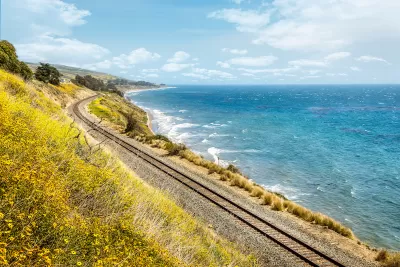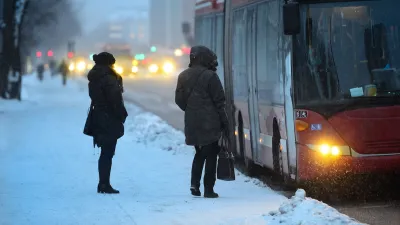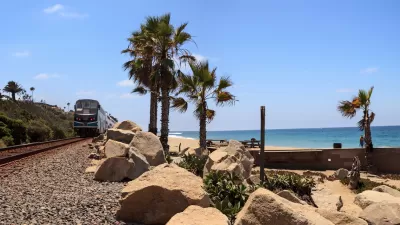Extreme weather and erosion threaten transit infrastructure around the country.

While transit agencies struggle to address the much-feared ‘fiscal cliff,’ physical cliffs pose another danger, writes Corrigan Salerno on Transportation for America.
As Salerno explains, “As climate change unfolds, transit will need the support to serve as communities’ resilient backbone through subtle, day-to-day challenges and demanding disasters.” In Southern California, one of the country’s top three busiest passenger rail corridors was disrupted for months due to coastal erosion that threatened the tracks. Now, the San Diego Association of Governments (SANDAG) is preparing a study for a new alignment that will relocate the tracks farther inland.
Salerno also points to the need for quick allocation and disbursal of emergency funds to repair weather-damaged infrastructure and restore service when disasters strike, similar to the FHWA’s Emergency Relief Program, which provides such funds for infrastructure repairs. “Just as repairs are needed for highways to continue functioning after a disaster, they’re needed to keep transit and passenger rail running on time so that people can get where they need to go.”
According to the article, “With the IIJA lapsing in 2026 and natural disasters on the rise with climate change, Congress needs to devise new policies to improve how the country restores public transit in the wake of earthquakes, hurricanes, wildfires, and even the less dramatic, predictable emergencies.”
FULL STORY: Transit’s physical cliff: Climate change

Alabama: Trump Terminates Settlements for Black Communities Harmed By Raw Sewage
Trump deemed the landmark civil rights agreement “illegal DEI and environmental justice policy.”

Planetizen Federal Action Tracker
A weekly monitor of how Trump’s orders and actions are impacting planners and planning in America.

The 120 Year Old Tiny Home Villages That Sheltered San Francisco’s Earthquake Refugees
More than a century ago, San Francisco mobilized to house thousands of residents displaced by the 1906 earthquake. Could their strategy offer a model for the present?

In Both Crashes and Crime, Public Transportation is Far Safer than Driving
Contrary to popular assumptions, public transportation has far lower crash and crime rates than automobile travel. For safer communities, improve and encourage transit travel.

Report: Zoning Reforms Should Complement Nashville’s Ambitious Transit Plan
Without reform, restrictive zoning codes will limit the impact of the city’s planned transit expansion and could exclude some of the residents who depend on transit the most.

Judge Orders Release of Frozen IRA, IIJA Funding
The decision is a victory for environmental groups who charged that freezing funds for critical infrastructure and disaster response programs caused “real and irreparable harm” to communities.
Urban Design for Planners 1: Software Tools
This six-course series explores essential urban design concepts using open source software and equips planners with the tools they need to participate fully in the urban design process.
Planning for Universal Design
Learn the tools for implementing Universal Design in planning regulations.
Clanton & Associates, Inc.
Jessamine County Fiscal Court
Institute for Housing and Urban Development Studies (IHS)
City of Grandview
Harvard GSD Executive Education
Toledo-Lucas County Plan Commissions
Salt Lake City
NYU Wagner Graduate School of Public Service





























